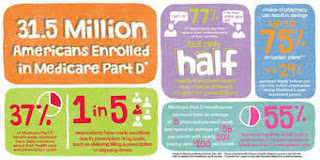Medicare Confusion
Could they possibly make it any more confusing to choose a Medicare policy? I'm going to go ahead and warn you that it would be impossible. I'm a guy of average intelligence who has managed businesses grossing millions of dollars a year, but when it came to figuring out this Medicare situation it was a nightmare. So here goes what you really need to know:
MEDICARE PART A: Everyone gets this as soon as you turn 65. You get it even if you are still working and have employer sponsored health care insurance. Understand that if you do have health care through your employer, it automatically becomes your primary policy. The only time part A will kick in is if you have maxed out your employer sponsored insurance, which in my case was "never".
Part A pays for services you need that require hospitalization. That's a little ambiguous as well, as it also covers services performed in a surgery center or a specialty center for certain diseases, and is not limited to the traditional "hospital" we think of when we use that term. Once you lose your employer sponsored insurance, this is what you will use for those types of services which require hospitalization. For instance, my wife had cataract surgery and we only had Medicare part A in force. Part A paid for most of the charges even though this is what I would have called outpatient surgery. We had to pay about $130 to the Ophthalmologist for the procedure and another $240 to the "surgery center" where the procedure was performed. She was there about 2 hours and went home. Medicare part A picked up the rest of the charges.
MEDICARE PART B: Here's where it starts getting tricky. You generally don't take part B when you turn 65 IF you are still working and have employer sponsored health care insurance because there is a monthly premium for Part B. Currently, the monthly premium is $134 per person; so $134 for you and $134 for your spouse each month. Again, your employer insurance is the primary paying policy, so this pays nothing until you max out your employer sponsored insurance benefits which, for me, was never.
Part B pays for visits to the doctor at the office. It also covers certain annual things like annual wellness checkout once every 365 days, some preventative vaccines, some preventative tests like a colonoscopy. If you don't sign up when you're 65, and say you work until you're 70 like I did, then you have to get proof from your employer that you had "credible" (equal to or better that medicare) insurance the entire time since you turned 65 until you retired. You must request a form from the Social Security office (or download from the Internet) and need one for yourself and one for your spouse. You complete that form, then your employer completes their portion, then you mail it in with your application (also downloaded from the medicare web site) to your local social security office.
Medicare A and B do NOT provide any type of prescription drug insurance. If you need/want prescription drug insurance, you must elect MEDICARE PART D and that's where it really starts to get confusing.
MEDICARE ADVANTAGE PLANS: Perhaps you've heard these mentioned. They even "talk about" them on the medicare web site. AARP (if you're a member) will send you information on the great plans offered through United Health Care for AARP members, but when you get all that information in the mail, it doesn't say anything about how to get a Medicare Advantage Plan. The Medicare web site doesn't say "how" to get an Advantage Plan. It is a mystery. Well, it's really just the three medicare plans rolled into one and managed by your choice of insurance carriers.
You first Must have Medicare Part A and Medicare Part B. You need to have those in place before you even go looking for the advantage plan which adds drug coverage and other benefits.
Medicare Advantage Plans are managed by private insurance companies on behalf of Medicare and are hybrid animals. They include Medicare Part A, Medicare Part B, plus Medicare Part D prescription drug plan. This is the plan most retired people have to ferret out. The best way to find out is to google insurance companies that sell medicare advantage plans in your area. They are specific to state and county, so you have to get the correct plan. Then CALL THEM - don't try to do it on line because it's too confusing, and ask about their Medicare Advantage with Prescription Drug plans. You can get an HMO plan for free usually, but you have to use specific doctors and hospitals. I got a PPO (Preferred Provider Plan) and I can use my current doctors and almost any doctor I want, and it provides drug coverage as well with tier 1 and tier 2 generic drugs free, for only $15/month. If you have to pay more than that, find another insurance company! What they charge you is IN ADDITION TO the $134/month you have to pay for Medicare Part B coverage.
They will tell you at the end after you've signed up for everything with the insurance company is that you also must continue to pay the $134/month for your Medicare Part B. So it's really $15/month in addition to what you would pay with Medicare part A + Medicare part B, but you have a wider range of doctors, hospitals, and clinics that you can use plus you have prescription drug coverage.
They will also tell you this is NOT a medicare supplement policy, but they may try to sell you one. Depending on your situation, that choice is up to you. The supplemental polices are generally expensive per month running from $100/month up to $500 or $600/month depending on your medical condition and what you think you might end up spending in medical expenses per year.
So perhaps that will help you understand a little better about the medicare situation when it's time for you to use it as your primary insurance.


Comments
Post a Comment